By Bus & Rail
A lonelier ride on Dodgers Express
August 3, 2011
You know the Dodgers are having a tough year when even the free bus service to the stadium is in a slump.
Ridership on the Dodger Stadium Express, which whisks ticketholders free of charge from Union Station to the stadium in clean-burning, natural gas-powered buses, dropped 19% in June and July. Passengers took 37,526 rides to and from the stadium on the Express during that period, compared to 46,337 rides during the same months last year.
On 16 occasions so far this year, regular season ridership on the dedicated fleet of buses has dipped below 1,000, hitting a low of 678 on Monday, July 25, when the Dodgers beat the Rockies 8-5. Last year, regular season ridership on the Express buses went below 1,000 just seven times. Overall, ridership this year to date stands at 81,518, compared to 82,222 at this time last year.
Metro launched the Express service’s rookie season last year with a $300,000 grant from the Mobile Source Air Pollution Reduction Review Committee (MSRC.) A $450,000 grant brought the buses back this year, along with some new post-game Metrolink train service, amid high hopes that the team and its fans would have a season worth celebrating.
It was not to be. The opening day beating of Bryan Stow, along with the team owners’ well-publicized divorce, bankruptcy filing and a dispiriting string of player injuries, set the tone for a dismal season in which attendance has plummeted and the Dodgers are struggling in the lowest rungs of their division. This week, a posting on The Los Angeles Times’ Dodgers blog carried the headline: “It’s official: The worst Dodgers season ever.”
Ridership was so low on Metrolink’s special post-game night trains that the agency recently cancelled the service to the Antelope Valley and Ventura County—although 11 p.m. trains to San Bernardino are continuing as part of the regular schedule.
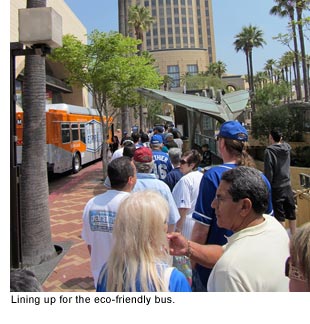 Yet there’s still hope that the Dodgers Express bus service—though possibly not the Dodgers themselves—will end up the season with the same or slightly better stats than last year. The National League East-leading Phillies are in town next week, and a half-price food-and-drink promotion will be in place for the 12:10 p.m. game on Wednesday, Aug. 10. Another bargain food-and-drink promotion is scheduled for Aug. 31, when the Dodgers play the Padres at 12:10 p.m. (The half-price deal doesn’t apply to alcoholic beverages—a policy change enacted after the Stow beating.)
Yet there’s still hope that the Dodgers Express bus service—though possibly not the Dodgers themselves—will end up the season with the same or slightly better stats than last year. The National League East-leading Phillies are in town next week, and a half-price food-and-drink promotion will be in place for the 12:10 p.m. game on Wednesday, Aug. 10. Another bargain food-and-drink promotion is scheduled for Aug. 31, when the Dodgers play the Padres at 12:10 p.m. (The half-price deal doesn’t apply to alcoholic beverages—a policy change enacted after the Stow beating.)
Both promos are expected to boost ridership and perhaps put the Express on track to equal or even slightly exceed last year’s totals, said Elizabeth Carter, Metro transportation contract services manager. (A Duke Snider bobblehead giveaway on Aug. 9 couldn’t hurt.)
“What really hurt our ridership this year was that incident that happened on opening day,” she said, noting that the economy and public perceptions about the McCourts’ divorce also played a role.
Still, if ridership ends up matching last year’s, that will represent a significant contribution to better air quality in the region. Ray Gorski, technical advisor to the MSRC, said that 77,000 car trips and 1.37 million travel miles were eliminated by virtue of the Dodgers Express service last year.
“I think we still consider the service a success,” said Conan Cheung, Metro’s deputy executive director of service development. He pointed out that, given lower Dodgers attendance levels this year, Express ridership may actually end up representing a higher proportion of fans opting to take the bus.
Those who choose the Express get the good feeling that comes from choosing the environmentally-friendly option, as well as a good deal: a free ride for ticketholders, $1.50 each way for those without.
“We’re getting a lot of compliments,” Carter said. “We get a lot of dedicated riders. They leave the driving to other people, and they don’t have to deal with the traffic.”
Posted 8/3/11
Expo Line picks up speed
March 24, 2011
As the first “road tests” begin on the initial phase of the new Exposition light rail project, a series of recent decisions is blazing the trail toward the line’s ultimate finish in Santa Monica.
A partial opening of the Expo Line from downtown Los Angeles to La Cienega is planned for this fall, with the conclusion of Phase 1 to Culver City expected next year. Meanwhile, work is beginning in earnest on Expo Phase 2, which will extend the line to Colorado and 4th Street in Santa Monica by 2015. (This interactive map shows the entire 15.2 mile route.)
Expo’s Board of Directors on March 18 voted to award the Phase 2 design-build contract to the firm Skanska/Rados. The board also voted to build an aerial crossing and station at Sepulveda instead of a street-level crossing, which was opposed by some neighborhood groups.
“Sepulveda is the major north-south thoroughfare on the Westside. Putting an at-grade crossing there is almost like putting an at-grade crossing on the 405 Freeway,” said Chuck Ray, co-chair of the Mar Vista Community Council’s Transportation and Infrastructure Committee, which backed the aerial option.
The elevated crossing and station will cost nearly $5.3 million more than the street level version. But the city of Los Angeles is picking up the tab for the additional cost, using money from the West L.A. traffic mitigation fund. (The motion by Councilmembers Paul Koretz and Bill Rosendahl is here.) The Phase 2 overall budget is $1.5 billion.
“This is an enhancement to the project. It will be a benefit to the project, to the city and to the Westside,” said Samantha Bricker, Chief Operating Officer for the Expo Line Construction Authority.
The Expo Board also voted in favor of the “no-parking” option at the Expo Line’s Westwood station. This option was preferred by some in the community, who feared that a proposed 170-space parking lot would draw too much additional traffic to their neighborhood.
“Putting a parking lot in the middle of our residential neighborhood is asking too much,” said Sarah Hays, co-chair of the group Light Rail for Cheviot.
Expo officials will be soliciting more public input for the Phase 2 design-build process at a series of community meetings in early May. (The dates will be announced soon.)
Meanwhile, the line’s Phase 1 progress was visible around USC earlier this week when a mock-up of a future Expo Line train (actually a flatbed pushed by something called a speed swing) took a ride on the tracks to make sure everything lines up properly with the station platforms.
Posted 3/24/11
Union Station goes Metro
February 24, 2011
Los Angeles’ Union Station—considered the “last of the great railway stations” in North America—will be bought by the Los Angeles County Metropolitan Transportation Authority for $75 million from its private owner, clearing the way for the fabled facility’s expansion.
Metro began negotiating its potential purchase of Union Station last November with owner Catellus Operating Limited Partnership. The deal, expected to be completed in April, includes 38 acres of land and 5.9 million square-feet of entitlements, giving Metro room to expand the site and generate lease revenues from transit operators and businesses. Several stores and restaurants (including Traxx Restaurant) operate out of station’s legendary main waiting room. With the purchase of Union Station, Metro adds to its current holdings of the adjacent Metro headquarters and the adjoining Patsaouras Transit Plaza.
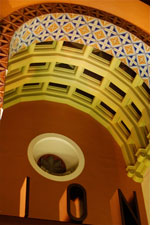 Initially approved by voters in 1926 as an alternative to a proposed regional elevated rail system, Union Station finally opened in 1939. World War II kept the station busy as a regional hub for lines such as the Atchison, Topeka and Santa Fe Railway, the Union Pacific and Southern Pacific Railroads. It also serviced the local Pacific Electric and Los Angeles railways. But the rail era would soon pass, giving way to a new age of air travel and the automobile. The Pacific Electric Red Car system was dismantled, and freeways began to increasingly dominate Southern California’s transit landscape.
Initially approved by voters in 1926 as an alternative to a proposed regional elevated rail system, Union Station finally opened in 1939. World War II kept the station busy as a regional hub for lines such as the Atchison, Topeka and Santa Fe Railway, the Union Pacific and Southern Pacific Railroads. It also serviced the local Pacific Electric and Los Angeles railways. But the rail era would soon pass, giving way to a new age of air travel and the automobile. The Pacific Electric Red Car system was dismantled, and freeways began to increasingly dominate Southern California’s transit landscape.
Today, the pendulum has begun to swing back, with a network of new public transit lines in operation or under construction. Once again, Union Station finds itself at the heart of our regional transit network. The station currently serves Amtrak, Metrolink, the Metro Red and Purple subway lines, the Metro Gold Line light rail, L.A. FlyAway bus service to LAX, and many other Metro regional and local municipal bus lines serving the region.
Even if you’ve never visited Union Station, odds are you’ve seen it. Partially designed by the father-son architectural team of John and Donald Parkinson (who also designed Los Angeles City Hall), it starred in its own 1950 thriller Union Station. And it had supporting roles in plenty of others, including Blade Runner, Silver Streak, Speed, and Pearl Harbor, not to mention countless TV shows.
.
Posted 2/24/11
Metro’s “Mad Men” riding high
October 20, 2010
Matt Raymond was an ad man on a mission when he set off for Metro headquarters in Los Angeles in 2002. Bound for a new job as the transportation authority’s incoming chief of communications, his first order of business was to find his new office at One Gateway Plaza. His second: “To make transit here cool.”
He didn’t fare so well on the first front. “You know how, when you get off the subway here, if you go one way you go to our building, and if you go the other way you go to Union Station?” Raymond confesses, chuckling. “Well, I went the wrong way.”
In his broader goal, however, everything seems to be headed down the right track. With a clear message and a talent pool that Don Draper himself would envy, Raymond’s in-house creative services department has spent the last eight years selling L.A. on mass transit the way gas-guzzlers have been pitched for generations by private ad agencies.
Under Raymond’s direction, Metro has been churning out the kind of prize-winning work usually associated with boutique ad firms. In the process, he and his team have reshaped the public image of the nation’s third-largest public transportation authority.
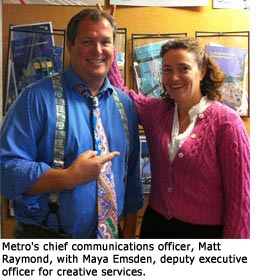 The creative services department, whose 13-person staff generates all the ads, maps, graphics, web/mobile data, merchandising and fleet design for Metro, has won more than 50 awards in the past five years for its rebranding efforts, including at least a half-dozen this year from such organizations as Harvard University’s John F. Kennedy School of Government and the Society of Environmental Graphic Design. Raymond was personally recognized this year for “dramatic improvements” in changing the perception of transit at the industry’s international Metros Awards.
The creative services department, whose 13-person staff generates all the ads, maps, graphics, web/mobile data, merchandising and fleet design for Metro, has won more than 50 awards in the past five years for its rebranding efforts, including at least a half-dozen this year from such organizations as Harvard University’s John F. Kennedy School of Government and the Society of Environmental Graphic Design. Raymond was personally recognized this year for “dramatic improvements” in changing the perception of transit at the industry’s international Metros Awards.
It’s a far cry from the mid-1990s, when the conventional wisdom about public transportation in Southern California was that it was useless and/or dysfunctional. After investing billions in L.A.’s first subway system, the agency’s finances had crumbled, and headlines routinely billed the MTA as profligate, quarrelsome and prone to engineering screw-ups.
The authority eventually improved, first under the leadership of corporate turnaround specialist Julian Burke and then under the recently retired Roger Snoble. But until Raymond was brought aboard in 2002, the agency’s image lagged.
“There was awareness of the agency,” he says, “but it didn’t have a very positive perception.”
Like Snoble, Raymond had come to Los Angeles from Dallas’ transit system, where marketing—not just to individual riders, but to businesses and community stakeholders—had been central to the mission. Advertising, he had learned, was not just billboards and commercials when it came to persuading a car culture to try mass transportation; everything from the look of the buses to the ease of the maps had to be part of the sales pitch.
For example: That wrong turn he made on his first day? Poor salesmanship, he decided.
“The first thing I did when I got the job was put better signage in all the stations,” he recalls.
More broadly, he believed that Metro needed a single, strong voice if the agency had any hope of getting through to car-centric Southern California. “Unbelievably, the agency didn’t have a central communications unit,” recalls Maya Emsden, Raymond’s deputy executive officer for creative services. “We had over 300 departments/programs, each with their own logo and each doing their own communications. The public didn’t even know some of them were part of the agency.”
Raymond corralled all those initiatives under a single communications department. Then Metro’s buses were repainted to drive home that friendly, consistent image—bright red for the rapid buses, “California Poppy” for the community locals, and silver for the express vehicles that travel the Orange Line’s dedicated busway. Then came a series of highly effective advertising campaigns that sold Metro as the simple solution to traffic, gas prices and other problems.
One award-winning campaign used simple pairs of black-and-white logos to depict Metro as, for example, the “hero” to the smoggy car “villain”, or the “sweet” solution to “bitter” gas prices. The ubiquitous images were on everything from bus benches to the t-shirts of baristas at L.A. cafes.
The creative services group—a closely-knit team that includes four graphic designers, one web designer and one signage designer—was transformed into Metro’s own mini advertising agency and print shop, saving the MTA huge sums on outside consultants. The group also taps local universities and art schools for talented interns, 10 to 15 of whom are on staff at any given time.
“Working with Metro has become a coveted job in these design schools, not only because we’ve been winning these awards, but also because of the pace and quantity of the work,” says Emsden. “Most internships, you work four months just to get a single brochure out. Here, we produce, like, two a week.”
Although the advertising has gotten the most attention, about 95% of the group’s time is spent on basic customer information that includes signage, literature, maps and such web features as Facebook, Twitter and Metro’s popular new blog, The Source. Coming soon: a new mobile app that tells customers when their next bus arrives.
Ethan Arpi, who is conducting a study of transit marketing for EMBARQ, the transit arm of the World Resources Institute, an environmental advocacy organization and think tank, says one key to Metro’s success has been its decision to give organizational stature to its communications chief.
“L.A. isn’t a transit-friendly market. It’s not just, ‘If you build it, they will come’, Arpi says. “If you build it, you have to sell it.”
Although it’s difficult to definitively assess the impact of Metro’s marketing efforts, transit advocates widely credit the communications group with persuading Southern Californians that the transit authority everyone loved to hate in the 1990s was actually a clean, hip, worldly alternative to their beloved cars.
According to public opinion and customer satisfaction surveys due for release by December, public approval of the authority has risen in the past eight years to a solid 64% this year from a lackluster 41% in 2002.
Some 98% of the public has heard of Metro, 79% are familiar with its system of buses and subways and 75% know about an actual service, such as a bus stop or rail line, near them, says Raymond. Also—and this is no mean feat, given the number of names the system has had over the decades—54% of the public now refers to the authority by just one name, “Metro” (as opposed to LACMTA or MTA).
Despite the encouraging numbers, some critics of the marketing strategy argue that Metro would do better to spend its money on improving its transit systems.
“I think they would better serve the public by making the system more accessible, rather than these ads that just say, ‘We have a bus and you can avoid traffic by taking it’,” says Nate Berg, a contributing editor at Planetizen.com, an urban planning news web site based in L.A.
“We know we have a bus. What we don’t know is where it goes, and when it’ll get there, and whether it will be there for them when they’re drunk in a bar at two in the morning.”
That said, however, Berg added: “I’ve got to say, they’re all over the place. And some of their ads are pretty good.”
Posted 10/20/10
Subway 90210 needs more review
October 19, 2010
L.A. County Supervisor and Metro director Zev Yaroslavsky is asking for more work on a staff-recommended Westside Subway route that leaves open the possibility of tunneling under Beverly Hills High School.
Yaroslavsky, addressing strong community opposition to going under the high school and nearby homes, won support Wednesday from a Metro committee for a broad study of the concerns raised by the residents.
“It’s not a done deal,” Yaroslavsky said of the proposed tunnel—a statement that brought a measure of relief to Lisa Korbatov, vice president of the Beverly Hills Board of Education. “We’re thankful he understands our issues,” she said after Metro’s planning and programming committee approved the motion.
Korbatov, testifying on behalf of a contingent of riled Beverly Hills officials and residents, said the Metro staff report that includes the possibility of tunneling under the high school is full of “gaping holes and glaring omissions.”
The argument that seemed to get the most traction, however, was whether a tunnel under the school would undermine a $334 million bond measure passed in 2008 by Beverly Hills voters to modernize the campus.
Among other things, the school plan calls for three levels of subterranean parking, according to Korbatov and other speakers, who said the tunneling would make this impossible. They’re pressing for an alternative route down Santa Monica Boulevard, which also would require further analysis because it sits directly above a seismic fault.
Yaroslavsky, in proposing further study, said he did not believe the school garage plan and the subway tunnel were mutually exclusive. “I’m going to take a very hard and objective look at this,” he said. He suggested that the residents of Beverly Hills do the same: “I would encourage you to work with us and keep an open mind.”
Specifically, Yaroslavsky is asking the Metro staff to explore a variation on the so-called Constellation Station Option that would avoid going under the historic high school building. He also wants a full exploration of the potential risks of having a subway line and station under Santa Monica Boulevard, on top of a seismic fault.
At the heart of the controversy is a Metro staff recommendation for a 9-mile extension of the Purple Line, which would run from Western and Wilshire to the VA Hospital in Westwood. The staff report leaves open where the line’s Century City station should be located–including both the option that goes down Santa Monica Boulevard and the option that goes under Beverly Hills High School.
But many in the city are adamantly opposed to any alternative that includes the high school.
“Beverly Hills residents do not want tunneling when there’s a viable alternative,” Korbatov said.
The full Metro Board of Directors will consider Yaroslavsky’s motion at its October 28 meeting. That’s when the board also will take up the Metro staff’s recommendation for the subway’s “locally preferred alternative” route.
Whichever route the board adopts will receive intensive study during the project’s final environmental review process. It also will help place the Westside Subway project in line for federal funding consideration in fiscal 2012.
Building the subway, which has a $4.2 billion price tag under the staff-recommended route, will require federal dollars along with revenues from Measure R, the half-cent sales tax approved by voters in 2008.
Posted 10/20/10
Metro’s favored Westside Subway route [updated]
October 14, 2010
Racing the clock to obtain federal funding commitments for the Westside Subway in the next fiscal year, Metropolitan Transportation Authority staff this week recommended what it considers to be the best, most cost-effective route for the project.
Under the “locally preferred alternative” favored by Metro, the Purple Line subway would be extended nine miles from the current station at Wilshire and Western to the VA Hospital in Westwood, at a cost of about $4.2 billion. Building the VA Hospital station, in addition to one at UCLA, would provide an important access point for the subway west of the 405 Freeway, the staff report said.
Metro’s Board of Directors will consider the recommendation at its meeting on October 28. Whichever route the board adopts will then undergo intensive study during the project’s final environmental review process. The board’s adoption of a preferred route also will move the project into competitive consideration for federal dollars in fiscal 2012. Those funds, along with revenues from Measure R, the half-cent sales tax approved by voters in 2008, will be needed to build the subway.
“We’re looking for federal dollars and the subway project is a really good candidate,” said Martha Welborne, Metro’s executive director of countywide planning. “We want to make sure we’re in the next cycle, or we’ll miss a whole funding year.”
In addition to the hoped-for “New Starts” funding, the federal government also is being asked to help accelerate the pace of building the subway under the 30/10 Initiative. Under that plan, local leaders are seeking to borrow against future Measure R revenues in order to fast-track an array of regional transportation projects. The aim is to complete the projects in 10 years, instead of 30.
The staff’s recommendation on the subway route came during the final stretch of a 45-day public comment period. But there’s still time to weigh in before the October 18 deadline. The electronic comment form is here.
The staff recommendation is one of five route alternatives—ranging in cost from about $4 billion to $8.7 billion—that were considered in the project’s Draft Environmental Impact Statement/Environmental Impact Report, issued in September. One of those would have added a series of subway stations in West Hollywood but Metro staff rejected that option, saying there is not enough funding to build the West Hollywood stops in addition to the Purple Line extension to the VA. That recommendation came as a disappointment to those in the community who had advocated strongly for the West Hollywood stations.
“There are a lot of disappointed people,” said Dan Wentzel, an actor/writer and transit advocate who writes a blog called The Pink Line. He said voters in West Hollywood had supported Measure R more than those in other cities, and have collectively responded to the subway plan by saying, “Build here! Build here!”
In Beverly Hills, however, many residents have expressed serious concerns about tunneling under homes and schools, particularly under Beverly Hills High School.
A full page ad in this week’s Beverly Hills Weekly, signed by more than 350 people and endorsed by numerous organizations, voiced support for a subway route under Santa Monica Boulevard and strongly opposed alternatives that would go under the high school.
A column in the newspaper quoted a Beverly Hills City Councilman, Barry Brucker, as calling Metro’s staff recommendation on the subway route a “slap in the face.”
In an interview, Brucker faulted the Metro report’s “glaring omission” of community concerns about tunneling under the high school–which he said is the primary issue about the subway in town.
“Not one word about the high school,” he said. “That led the whole community to believe this is all a whitewash and a fait accompli.”
The staff-recommended route would have seven stations, six of them along Wilshire Boulevard: La Brea, Fairfax (next to the Los Angeles County Museum of Art,) La Cienega, Rodeo Drive, Westwood/UCLA and the VA Hospital. The line also would extend into Century City for one station before rejoining Wilshire. The staff recommended leaving the exact placement of the Century City and Westwood stations open for further analysis during the final environmental review process.
The staff recommendations, contained in a report to Metro committees scheduled to meet next week, propose dropping a possible station at Crenshaw and Wilshire. Doing so would save $153 million and improve the project’s “cost-effectiveness index” (a measurement of cost per hour of “user benefit”) to $31.96, the staff report said. That would make the subway a better candidate for inclusion in the next phase of the Federal Transit Administration’s “New Starts” program, which favors projects with a cost-effectiveness index of $31 or less.
The staff also recommended against building a “connection structure” that would have served as a gateway for future heavy rail stations in West Hollywood. It suggested that other transit alternatives—such as a light rail subway—might end up being a more cost-effective option for West Hollywood, which would make the structure unnecessary.
Transit blogger Wentzel said he was encouraged by the report’s acknowledgment that a West Hollywood line “has very high potential as a transit corridor.”
“That’s the one silver lining,” Wentzel said, describing himself as a continuing subway backer and an optimist about bringing transit alternatives to West Hollywood. “It’s a miracle how far the Santa Monica Boulevard corridor has come.”
Posted 10/14/10
Updated 10/21/10: Metro’s Board of Directors will consider the Westside Subway project at their meeting at on Thursday, Oct. 28. For more information, including how to get there via public transportation, click here.
Big step on subway’s long journey
September 10, 2010
And away we go.
After years of public meetings and study, the long-standing effort to bring a subway to the Westside of Los Angeles passed a key milestone today, with the release of a draft environmental impact statement spelling out potential routes to carry riders from the Mid-City area to Westwood.
The subway, an extension of Metro’s Purple Line and potentially the Red Line as well, will become a faster-moving transit alternative as traffic gridlock worsens in coming years, according to an executive summary accompanying the project’s Draft Environmental Impact Statement/Environmental Impact Report.
In justifying the need for the new subway, the report paints a grim picture of what the future might look like without one. By 2035, it projects 51,000 new residents and 58,000 new jobs in the area closest to the proposed subway. And that means more cars on clogged roadways and more people packed into buses, resulting in even slower commute times. Buses would slog along at 8 to 11 miles per hour and would add 29% more riders by 2035, the report said.
Even with the coming of the subway, the report promises very little in the way of easing roadway congestion. “The subway is not a silver bullet to cure all the traffic problems on the Westside,” said Metro spokesman Dave Sotero. But, he said, when combined with other improvements, it will offer a “fast, clean, reliable alternative to driving in traffic.”
Metro’s blog The Source did the math and found that what’s now a 54-minute cross-town odyssey from Union Station to Westwood using public transportation would become a 25-minute trip once the subway is built.
The subway also promises to open up a world of Westside offerings—from jobs to education to entertainment and culture—for people across the region.
The draft plan made public today sets out five possible routes for the subway. One begins at Western and moves west along Wilshire, stopping at stations at La Brea, Fairfax, La Cienega, Rodeo Drive, Century City and Westwood/UCLA. Another adds a station at the Westwood VA Hospital. Another goes further, running along Wilshire all the way to 4th Street in Santa Monica. Other alternatives would add stations in West Hollywood near the Beverly Center and along Santa Monica Boulevard, and would provide connections to the San Fernando Valley via the Red Line.
Some key decisions still must be made, however, including whether to build a station at Crenshaw and Wilshire, and where precisely to place many of the stations.
The public is invited to comment on the draft EIS/EIR in a series of meetings beginning later this month. The first will be held from 6-8 p.m. at LACMA on Sept. 20. A complete list of meetings and locations is here.
After a 45-day public comment period, the Metropolitan Transportation Authority’s board will decide at its Oct. 28 meeting whether to approve the draft report along with a “locally preferred” alignment. Then work will get underway on a final environmental report for the project, along with preliminary design work.
Depending on which route is selected, the project could cost from $4 billion to $8.7 billion, the report said. Getting the subway as far as Westwood could be funded with revenues from Measure R, the half-cent sales tax approved by voters in 2008, along with anticipated federal matching funds. Adding the West Hollywood or Santa Monica leg would require finding additional funding sources.
The federal government also is being asked to help accelerate the pace of building the subway under the 30/10 Initiative, in which local leaders are seeking to borrow against future Measure R revenues in order to fast-track major transit projects in the region. The infusion of federal dollars could allow the projects to be completed in 10 years, instead of 30.
Posted 9/03/10
She’s got a ticket to ride
September 10, 2010
Ever since Faye Kingslee moved to Los Angeles about six months ago, public transportation has been more than just a ride for the aspiring actress.
It’s been a rolling office, a mobile dressing room to put on makeup before auditions and a source of endless creative inspiration provided by a colorful, ever-changing cast of fellow riders.
Now public transportation is taking Kingslee on another kind of ride. Her short video, “The Heartbeat of LA,” just won top honors in Metro’s Transit Flicks Video Contest.
The win means more than just a free one-year EZ transit pass for Kingslee, an Australia native who has lived and worked all over the world, from Singapore to New York. It also was a chance to bring her favorite kind of storytelling to a new audience.
And, it turns out, an opportunity to introduce her volunteer cast and crew to the joys of mass transit.
“All the people who I brought on to work on this project with me had never been on the train before,” Kingslee said. She described the 6 a.m. to 9 a.m. shoot, aboard a Metro Red Line train traveling between Union Station and North Hollywood, as a “really guerilla style” operation.
The 2-minute film depicts a sweet, silent encounter between two subway passengers—Kingslee and fellow actor Bryson Kuan—that looks like it just might blossom into something bigger.
Like other films turned out by Kingslee’s ShortFilmsWeekend collective—a nonprofit that brings together various volunteer craftspeople to create movies seen on YouTube—her inspiration came from what she sees around her, often on the bus or train.
“It randomly happens sometimes,” she said. “You can have connections and moments with people.”
Her concept, turned into a script by Alix Reeves and directed by David Redish, was selected over six other finalists, winning 26.58% of 1,000-plus votes cast by the public in the contest.
Kingslee, who aspires one day to have her own production house, lives in Hollywood and usually rides her skateboard to get to her Red Line stop. “I’ve actually been high-fived” rolling along Hollywood Boulevard, she said.
And six months in L.A. haven’t changed her original decision to live car-free.
“I’m still sticking with public transit,” she said. “I still don’t have a car. It’s a way of life.”
Posted 9/10/10
Movie magic, Metro-style
September 2, 2010
Don’t look now, but a miniature multiplex has set up shop in your computer. It’s got something for everybody: romantic comedy, travel/adventure, coming of age, urban documentary. You’ll laugh, you’ll cry, you might even forget about YouTube for a few minutes. Because these are micro-movies with a mission. The shorts, none longer than 2 minutes, are the finalists in the Metropolitan Transportation Authority’s Transit Flicks Video Contest. Each was selected for “originality, believability and how well they convince others to try transit.” Now it’s your turn to pick the best of the lot. Watch the movies and cast your ballot here before midnight on Tuesday, Sept. 7.
The grand prize winner gets a free EZ pass for a year…and, who knows, maybe a shot at Tinseltown immortality. Or at least bragging rights on the morning Metro Rail commute.
Posted 9/02/10




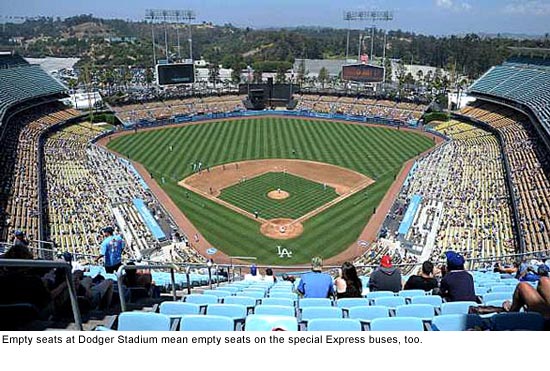
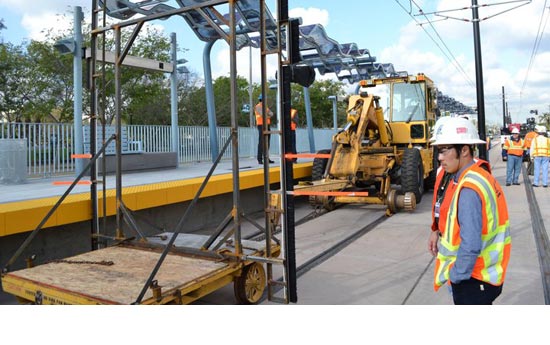
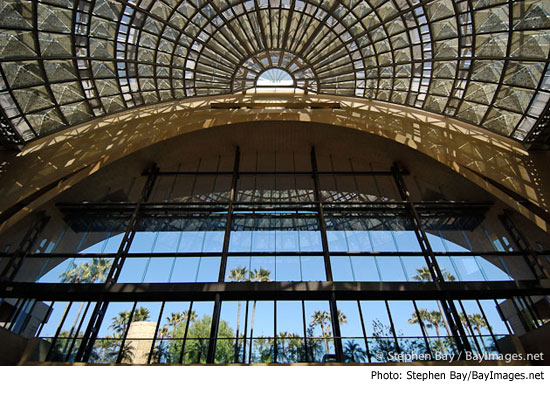










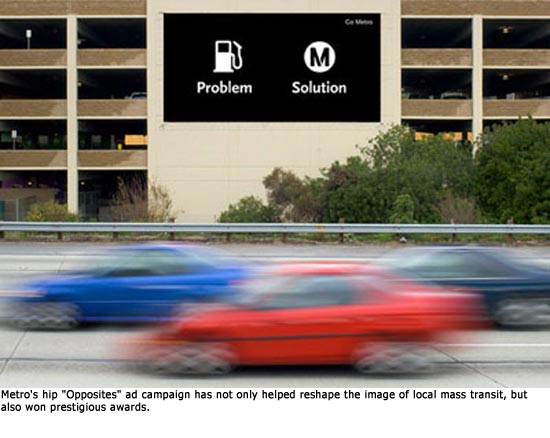

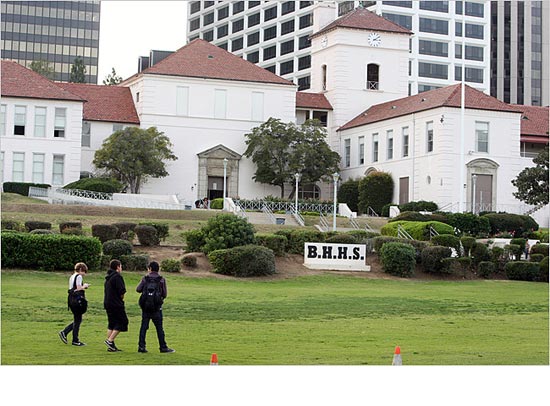
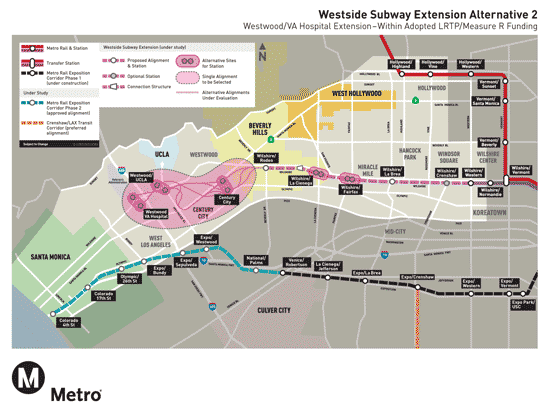
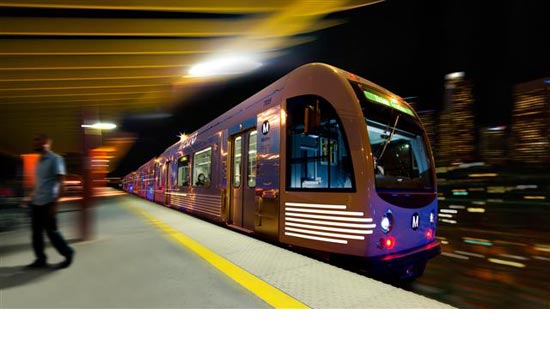
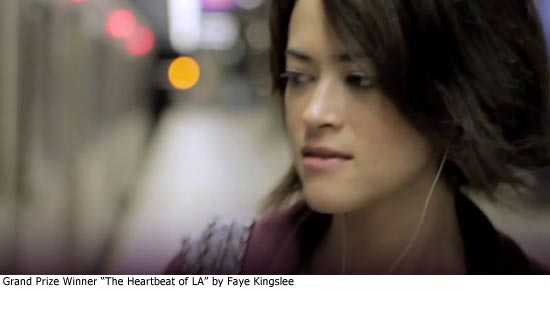
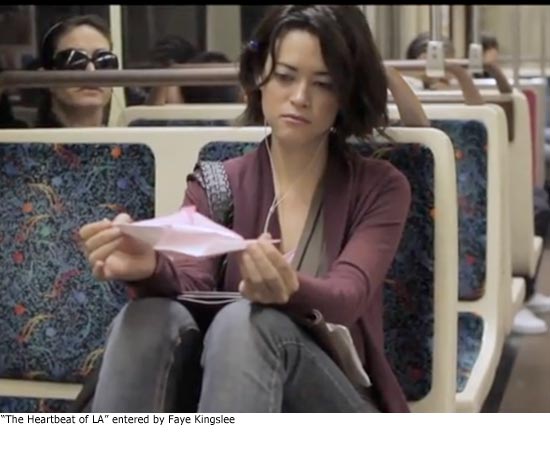







 405 bridge work causes a stink
405 bridge work causes a stink

